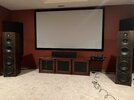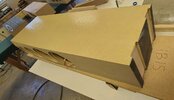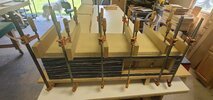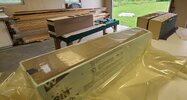Very impressive work here Meagan!
You are using an out of date browser. It may not display this or other websites correctly.
You should upgrade or use an alternative browser.
You should upgrade or use an alternative browser.
MEADOWLARK AUDIO SHOP PICS
- Thread starter Pat McGinty
- Start date
-
- Tags
- active cad dsp hypex meadowlark pat mcginty satori
Those look spectacular. Congratulations.Another bird singing in central Indiana. Thank you again Pat and Meagan!
Thank you! What a revelation in sound! Can’t wait to see how they settle in.
Yeah, no open toe shoes. But that wasn't a work day, just a glam shot session on the weekend. No flip flops, loose hair, no snaggable jewelry, mandatory hearing and eye protection. No risky procedures. We're really good at not getting hurt.Looking great!
Tell Meagan though, no open toe shoes in the shop.
Hey Pat, just a woodworking cabinet question. Since you are veneering these boxes, why still do a 45 miter joint?
Great idea with the additional width on the bottom.
We do miter joints to avoid glue line telegraphing by moving the glue line to the edge. If you do butt joints with 3/4" or 1" MDF, they will eventually become apparent when the surface happens to be arranged to show a reflection.
Avoiding the "appearance" of glue lines is tricky. Back when we were a production shop, I invented an easy to execute in CNC joint ((and named it after myself
 ha ha)) that avoided the appearance of glue lines, without the pita of miters, by moving the line to less than 1/4" from the edge - where the eye just can't pick it up. It's trick, yes, but it works really well. You can look right at it, even knowing there must be a glue line, but you can't see it.
ha ha)) that avoided the appearance of glue lines, without the pita of miters, by moving the line to less than 1/4" from the edge - where the eye just can't pick it up. It's trick, yes, but it works really well. You can look right at it, even knowing there must be a glue line, but you can't see it.
And own lots of clamps!Any guys interested in applying veneer?
Q: How much glue to use?
A: Just enough to barely, but completely, coat both the substrate and veneer panel.
Titebond II. Check for boogers! Clamp for 1 hour, min.
View attachment 49555
View attachment 49556
View attachment 49554
10 mil paper backed. We used curved battens to apply slightly more pressure at the center than along the edges. That lets us off the hook for squeezing out any air pockets; the process just takes care of that. But you do have to keep a sharp eye out for the platten/wet veneer assy creeping off the work owning to tiny amounts of lateral bias in the clamping pressure. You do your best to set the clamp axes perpendicular to the load, but when you squeeze this hard, a small amount can show up, potentially ruining the job.Nice. That's raw veneer - wood backed?
Dont forget the roller and burnishing.
Yeah, I just can't get the perfect flatness or the tight edge seams we're after with contact cement.I've been using contact cement on paper backed, letting it get tacky first. You prefer the titebond?
Wish I had a vac bag. At some point. Until then, only rectangular speakers.
Titebond II forms a bond that's stronger than the materials you're bonding, so we never have to worry about a delam.
Yep. Or Titebond Cold Press, which makes for less trouble with squeeze thru on porous veneers.
Those will be stunning.
We're finishing up two sold pair of Kingfishers, a design that I haven't listened to in a while, so I thought to spend some time reevaluating the voicing. In filter design, like writing prose, putting some time between efforts can bring better results; let you see your work in a fresh light.
That's what happened. Apparently, I put had my thumb on the scale in favor of output over bandwidth. Now, when you think about it, no one's gonna go for a dual six incher who's hell bent on output. Giving him a pleasant surprise on the LF side of things makes much more sense.
The twin Satoris can take it, so I dialed in 6dB of boost above a 30Hz cutoff. Very nice. But, obviously, there will be an output limitation, so how much? You do want to be able to play aggressive, bassy music at satisfying levels, considering the customer's room size. A handy baseline is being able to deliver the opening of Dark Side of the Moon at 0dB in, while not bottoming out. Mr. Beck's Morning Dew, too. Maybe close to bottoming, but just not. Meaning you're using all the woofer you have, but not more. In setting the LF contour against max possible level, the idea is to find that fine line between "weighty and vigorous" and making it very difficult to hurt the thing.
There's no noticeable overshoot in the LF system, so going a little bit full on the presentation is good, won't sound thick, can't. The speaker is kinda tiny, but comes across brawny and poised.
Here's what the controls look like, in a darkened room, for doing the job.
I was using that album, an old standby - to evaluate, not bass, but focus, staging depth and vocal believability. Smart percussion. Sax juicy, not reedy. Male and female, plus children's voices, all simple two mic setups from bit of a distance. A good series of tests for naturalness.

You can see the five pole Butterworth LP at 275Hz - something that would not have worked back in the days of passive filters. You would have had to run the woofers much up higher, congesting the vocal range when running hard.
In this setup you can work the woofers as hard as you like, while the 5" low mass midrange has an easy time.
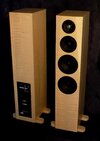
That's what happened. Apparently, I put had my thumb on the scale in favor of output over bandwidth. Now, when you think about it, no one's gonna go for a dual six incher who's hell bent on output. Giving him a pleasant surprise on the LF side of things makes much more sense.
The twin Satoris can take it, so I dialed in 6dB of boost above a 30Hz cutoff. Very nice. But, obviously, there will be an output limitation, so how much? You do want to be able to play aggressive, bassy music at satisfying levels, considering the customer's room size. A handy baseline is being able to deliver the opening of Dark Side of the Moon at 0dB in, while not bottoming out. Mr. Beck's Morning Dew, too. Maybe close to bottoming, but just not. Meaning you're using all the woofer you have, but not more. In setting the LF contour against max possible level, the idea is to find that fine line between "weighty and vigorous" and making it very difficult to hurt the thing.
There's no noticeable overshoot in the LF system, so going a little bit full on the presentation is good, won't sound thick, can't. The speaker is kinda tiny, but comes across brawny and poised.
Here's what the controls look like, in a darkened room, for doing the job.
I was using that album, an old standby - to evaluate, not bass, but focus, staging depth and vocal believability. Smart percussion. Sax juicy, not reedy. Male and female, plus children's voices, all simple two mic setups from bit of a distance. A good series of tests for naturalness.

You can see the five pole Butterworth LP at 275Hz - something that would not have worked back in the days of passive filters. You would have had to run the woofers much up higher, congesting the vocal range when running hard.
In this setup you can work the woofers as hard as you like, while the 5" low mass midrange has an easy time.

We've been kicking two ideas around:
1) Breaking Ibis into two stacked cabinets, like Nightingale, for the purpose of making it easier for us to deal with during production.
2) Nightingale, being the best seller, we'd like to see what happens at the next level up by adding adding Satori's ridiculously good 5" midrange, the one we enjoy so much in Kingfisher and Harrier. Plus going with the dual upper bass driver idea that brings the grins in the lab. and by upping the LF capabilities by at least twice, for guys with extra large rooms, or guys after more action in the teens.
It's convenient that the Ibis ideas and the 'next level up' from Nightingale ideas work side-by-side.
At first, we imagined making twin side-by-side towers. One being the revised Ibis, the other being four tens, divided into two stacking cabinets.
I tried the idea on a few customers and got a tepid response. Maybe guys don't want to see that much baffle: one 11" wide and one 14" wide. Seems great to me, being faced with that much transducer. But maybe it's the WAF - maybe guys just don't want to say it. On the other hand, guys rarely object to depth. So perhaps there's a way to score the performance increment in a more appealing way?
The SB Acoustics guys, who make the Satori line we're using, are making a dandy 13 incher with a 30mm Xmax P-P. Large coil, great venting and a very impressive motor force spec. 'have some on the way.
Also, the force cancelling idea for LF systems has always been a favorite. I'm always looking for opportunities to execute it in our custom work. You simply orient the woofers coaxially and so that the mechanical moments are 180 degrees out of phase - that way the mechanical effects null. I have one in the knee well of my desk, and it's kinda spooky: you can't notice that it's operating, even with one foot on it, just sonic output from a perfectly still and quiet cabinet. We've made several big ones, always impressive. And so cool.
Anyway, this idea popped up. Whaddya think?
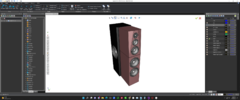

1) Breaking Ibis into two stacked cabinets, like Nightingale, for the purpose of making it easier for us to deal with during production.
2) Nightingale, being the best seller, we'd like to see what happens at the next level up by adding adding Satori's ridiculously good 5" midrange, the one we enjoy so much in Kingfisher and Harrier. Plus going with the dual upper bass driver idea that brings the grins in the lab. and by upping the LF capabilities by at least twice, for guys with extra large rooms, or guys after more action in the teens.
It's convenient that the Ibis ideas and the 'next level up' from Nightingale ideas work side-by-side.
At first, we imagined making twin side-by-side towers. One being the revised Ibis, the other being four tens, divided into two stacking cabinets.
I tried the idea on a few customers and got a tepid response. Maybe guys don't want to see that much baffle: one 11" wide and one 14" wide. Seems great to me, being faced with that much transducer. But maybe it's the WAF - maybe guys just don't want to say it. On the other hand, guys rarely object to depth. So perhaps there's a way to score the performance increment in a more appealing way?
The SB Acoustics guys, who make the Satori line we're using, are making a dandy 13 incher with a 30mm Xmax P-P. Large coil, great venting and a very impressive motor force spec. 'have some on the way.
Also, the force cancelling idea for LF systems has always been a favorite. I'm always looking for opportunities to execute it in our custom work. You simply orient the woofers coaxially and so that the mechanical moments are 180 degrees out of phase - that way the mechanical effects null. I have one in the knee well of my desk, and it's kinda spooky: you can't notice that it's operating, even with one foot on it, just sonic output from a perfectly still and quiet cabinet. We've made several big ones, always impressive. And so cool.
Anyway, this idea popped up. Whaddya think?



